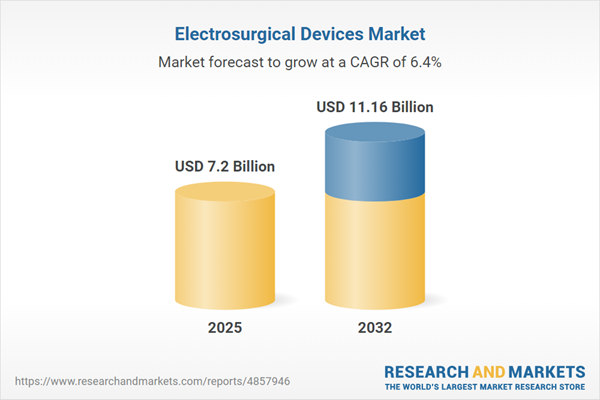Speak directly to the analyst to clarify any post sales queries you may have.
The electrosurgical devices market is advancing rapidly as hospitals and clinics seek greater surgical precision, safety, and efficiency through technology adoption. Senior decision-makers need clear insights into strategic growth factors, key challenges, and emerging opportunities across this dynamic sector.
Market Snapshot: Electrosurgical Devices Market Growth and Outlook
The Electrosurgical Devices Market grew from USD 6.79 billion in 2024 to USD 7.20 billion in 2025. It is expected to continue growing at a CAGR of 6.40%, reaching USD 11.16 billion by 2032.
Accelerated adoption is driven by the need for precise tissue management, integrated safety features, and improved interoperability with other operating room technologies. Notably, hospitals, specialty clinics, and ambulatory surgical centers are seeking solutions that combine performance, patient safety, and workflow optimization across a range of clinical applications and care settings.Scope & Segmentation
- Product Type: Generators, instruments & accessories, smoke evacuation systems
- Instruments & Accessories: Cords & cables, electrodes, footswitches, handpieces/pencils
- Modality: Bipolar electrosurgery, monopolar electrosurgery
- Portability: Portable/handheld devices, stationary systems
- Functionality: Coagulation, cutting
- Reusability: Reusable instruments, single-use
- Application: Cardiovascular surgery, dental surgery, dermatology/cosmetic surgery, ENT, gastroenterology, general surgery, gynecology, neurosurgery, oncology, orthopedic surgery, urology
- End-User: Academic & research institutes, ambulatory surgical centers, hospitals, specialty clinics
- Distribution Channel: Offline, online
- Regions: Americas (North America, Latin America), Europe, Middle East & Africa, Asia-Pacific
- Key Companies: Ambu A/S, B. Braun Melsungen AG, Boston Scientific Corporation, Bovie Medical Corporation, BOWA-electronic GmbH & Co. KG, BPL Medical Technologies, CONMED Corporation, Cook Medical LLC, Erbe Elektromedizin GmbH, Integra LifeSciences Corporation, Johnson & Johnson Services Inc, Karl Storz SE & Co. KG, Medline Industries Inc., Medtronic plc, Olympus Corporation, Richard Wolf GmbH, Smith & Nephew plc, Steris Corporation, Stryker Corporation
Key Takeaways and Strategic Insights
- Innovation in electrosurgical device design is advancing procedural control and safety through power management, integrated safety monitoring, and user-centric interfaces for clinicians.
- Miniaturization and portability are allowing broader adoption in outpatient, remote, and field medical contexts, extending the utility beyond hospital operating rooms and enabling point-of-care treatment delivery.
- Integration with robotic systems and advanced visualization tools is enhancing surgeon dexterity, precision, and workflow, facilitating improved outcomes for both routine and advanced surgical interventions.
- Adaptability to different clinical needs is achieved through product modularity, a variety of accessorial configurations, and a balance between reusable and single-use devices to address sterility, ease of use, and cost-management goals.
- Supplier strategies now emphasize closer customer partnerships and service agreements that align cost with clinical usage, which supports long-term procurement optimization and predictable device uptime for providers.
- Global collaboration among manufacturers, researchers, and software partners is accelerating innovation cycles, ensuring adaptation to diverse hospital infrastructures and regulatory standards worldwide.
Tariff Impact on Electrosurgical Devices Supply Chains
Recent tariff adjustments in the United States have increased import costs for essential components and finished electrosurgical systems. This has prompted manufacturers to reconsider sourcing and logistics strategies, including shifting to nearshoring or regional assembly to mitigate exposure to tariff volatility. Healthcare providers are responding with long-term contracts and flexible procurement strategies, supporting supply stability and cost control despite changing trade environments.
Electrosurgical Devices Market: Methodology & Data Sources
This research deploys a hybrid methodology combining expert interviews, procurement specialist insights, and clinical user feedback with comprehensive secondary analysis. Data sources include regulatory filings, clinical trials, technical literature, corporate communications, and patent reviews. Data triangulation is applied to ensure alignment, trend validation, and scenario-driven stress testing for robust, actionable market intelligence.
Why This Report Matters
- Offers actionable guidance for senior leaders seeking to strengthen procurement, supply chain resilience, and technology partnerships in a competitive marketplace.
- Supports capital allocation and portfolio management by highlighting emergent trends, regulatory shifts, and key growth opportunities across regional markets and care delivery settings.
- Helps clinical and commercial teams align innovation roadmaps with evolving clinical, regulatory, and patient safety requirements globally.
Conclusion
The Electrosurgical Devices Market is shaped by technology-driven advancements, shifting trade dynamics, and strategic collaboration. Stakeholders equipped with reliable insights can better navigate complexity, prioritize investments, and support ongoing improvements in surgical care delivery.
Additional Product Information:
- Purchase of this report includes 1 year online access with quarterly updates.
- This report can be updated on request. Please contact our Customer Experience team using the Ask a Question widget on our website.
Table of Contents
3. Executive Summary
4. Market Overview
7. Cumulative Impact of Artificial Intelligence 2025
Companies Mentioned
The companies profiled in this Electrosurgical Devices market report include:- Ambu A/S
- B. Braun Melsungen AG
- Boston Scientific Corporation
- Bovie Medical Corporation
- BOWA-electronic GmbH & Co. KG
- BPL Medical Technologies
- CONMED Corporation
- Cook Medical LLC
- Erbe Elektromedizin GmbH
- Integra LifeSciences Corporation
- Johnson & Johnson Services, Inc
- Karl Storz SE & Co. KG
- Medline Industries, Inc.
- Medtronic plc
- Olympus Corporation
- Richard Wolf GmbH
- Smith & Nephew plc
- Steris Corporation
- Stryker Corporation
Table Information
| Report Attribute | Details |
|---|---|
| No. of Pages | 194 |
| Published | November 2025 |
| Forecast Period | 2025 - 2032 |
| Estimated Market Value ( USD | $ 7.2 Billion |
| Forecasted Market Value ( USD | $ 11.16 Billion |
| Compound Annual Growth Rate | 6.4% |
| Regions Covered | Global |
| No. of Companies Mentioned | 20 |









